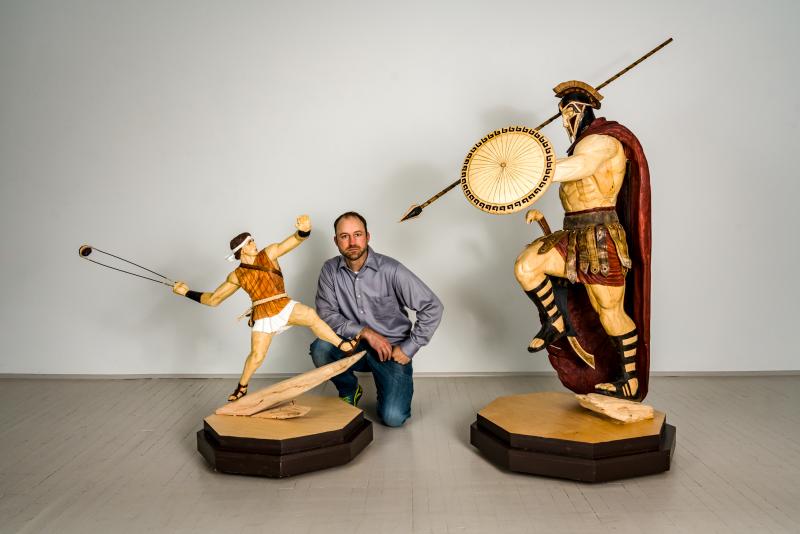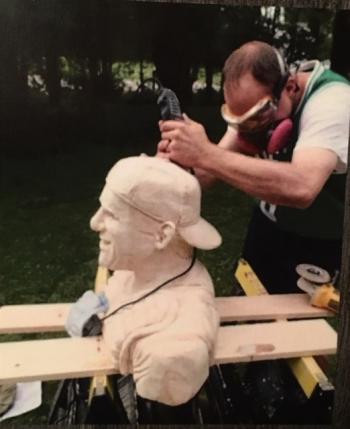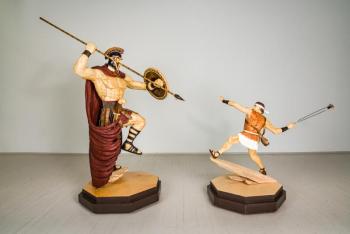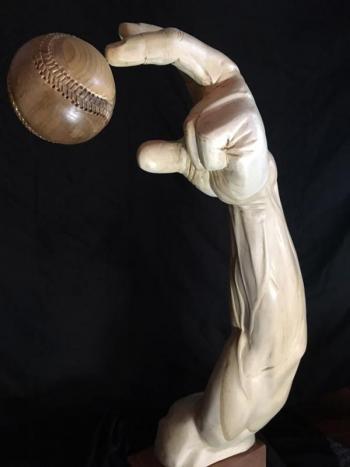Basketball coach and artist Jon Moro on unleashing creativity
ROCKPORT — Carving wooden life size sculptures of sports figures has been a passion for Rockport artist Jon Moro, who recently departed from sports figures to crafting a life size sculpture of two Biblical figures. They were unveiled Oct. 17 at Barnswallow Books, in Rockport Village.
“I’m fascinated by the challenge of creating a sense of movement, and emotion from a still, inanimate object,” Moro said, on his website. “A meaningful sculpture has power, presence and humanity, and generates its own unique narrative.”
It was not until he was 20 years old that Moro began to think of himself as an artist.
“I had pursued a more academic track in high school, always enjoying projects that involved a poster or drawing, but didn't have time in my schedule for an elective art class,” he said. “After two years in college as an English major, I took a break from school. At that point I started working with wood, making all kinds of sculptural creations. Although the pieces were very rough and sometimes incomplete, something clicked inside of me that said, ‘I can do this!’ Within a few years I started taking art classes. My first class was an adult education oil painting class — I took it four times!”
From there, Moro began working at Home Depot, which he said provided even more inspiration for his art pieces, and began to take a few classes per semester at the University of Maine at Augusta.
Moro, the head boys basketball coach of the varsity team at Camden Hills Regional High School, is inspired by history, athletics, and themes of trial, struggle and triumph that encompass the human experience, according to his artist biography. His sculptural work, the biography reads, focuses primarily on humans in motion, from figures to life-size pieces, and each is carved and shaped from wood.
Wood his chosen medium to work with as he describes it as warm, familiar, organic and ultimately alive — “perfect for conducting memories,” as opposed to plastic, or cold-to-the-touch metal.
“There is always something below the surface of a piece of wood,” he said. “Grain is individual, and yet marks every species distinctively. Our eyes see shape, but we also see the grain. Grain is a life lived. It is a surface with a past. Every piece is the result of a collaboration. The life of the wood, and the shape the sculptor gives it. It is a unique connection between artist and medium, past and present, something crafted, yet something living.”
Moro has crafted several sports figures into life size sculptures, including basketball hall of fame inductees Kevin Garnett and Julius Erving, baseball hall of fame inductee Yogi Berra, hockey hall of fame inductee Paul Kariya, and professional baseball player Nomar Garciaparra.
He also created a sculpture, “The Crossover,” that is on display at the National Collegiate Athletics Association Hall of Champions museum in Indianapolis, Indiana, which received an award from the NCAA for the art piece.
Asked to identify his favorite piece, Moro at first compared the question to asking a parent to pick their favorite child, before conceding his most recent piece, David and Goliath in this moment, is always his favorite.
“However I think my Kevin Garnett piece was very successful, as well,” he added. “It really reflected his personality, his size, and had a spiritual element to it.”
Moro can usually complete a life size sculpture within 12 months, if he has uninterrupted time to work on the piece. David and Goliath took three years, however, to craft amid various commission pieces Moro was hired to create, and its finish was actually boosted thanks to the pandemic.
“My major ‘push’ happened in the spring after Camden Hills [Regional High School] went to remote learning,” said Moro, who is also an ed tech at the high school. “I worked for seven months straight, and that was exactly what I needed to maintain momentum and finish the pieces. It’s a long process. But I do feel that time was my secret weapon; nothing about David and Goliath was impulsive.”
Along the way of creating his David and Goliath piece, there were many creative problems for Moro to solve: armor, colors of clothing, how David and Goliath interact with each other.
“There were also practical problems: how to secure and stabilize the sculptures, how to move them, how to make sure the pieces were solidly constructed,” Moro said. “The duration of the project allowed the best ideas to come to the surface.”
The idea of sculpting life size sculptures of David and Goliath came to Moro fairly quickly, recalled, and the first step was to gather as many reference images as possible through Google Images and other research.
“I looked up hundreds of illustrations depicting the battle, and every sculpture I could find that had already been done,” stated Moro. “It was just a wide open, brain-storming session.”
After much research, Moro narrowed down his options to a few concepts he liked most and realized he was keen on showing the two fully engaged in battle, opposed to remaining static and simply looking at each other.
“I found a ‘look’ that I wanted the piece to have, as well as distinctive weaponry and clothing,” said Moro. “Now that I had a plan, I started getting really specific with the images I wanted for reference. I used over 100 images; pictures of muscles, clothing, facial references, armor ideas, sometimes parts of toy action figures. I print them all out and have them right next to my work area.”
Ideas for how the sculpture should be crafted came to Moro at all hours of the day with the artist sketching out the newest thought as soon as he could.
“During this project, ideas would come in the morning as I woke up, in bed when closing my eyes, and sometimes during my work day,” he said. “For a while I thought this was weird because I was ALWAYS thinking about [the piece]. It turns out that this is a normal part of being a sculptor. Sketching was a way to work out my creative problems and record the ideas that popped up at random moments of the day.”
To create the actual sculpture, Moro used a chainsaw to rough out his design.
“I use and angle grinder with a wood-carving wheel (a disc with metal spikes on it) to get the muscles defined, and then a Dremel tool for fine details, he said, noting he went through a bunch of sandpaper.
The piece was inspired by the fact Moro believes each individual is a version of David, at some point life, tasked with facing a version of Goliath.
“We all face scary things,” he commented. “It’s easy to look at our opposition and forget the unique abilities that we have inside. Appearances can be deceiving. Having a growth mindset where anything is possible can unleash our creativity and give us victory.”
Moro’s advice for young artists is to be dedicated to the craft, while still enjoying the journey.
“Be in it for the long run,” he said. “Don’t compare yourself to other artists who have been working at their craft for decades. Any point of development is a good point, as long as you are enjoying it. I had an art teacher say to my class one day, ‘good art is not about your first piece… it’s not about your first five pieces… it’s about your first 50 pieces. And then it’s about the next 50 after that.’ You have to put in the work.”
Enjoy the journey of personal growth as an artist, Moro said.
“It’s not always glamorous, but growing as an artist should be fun,” he said. “Just because your creation doesn’t look like Michelangelo’s work at age 22, doesn’t mean that you can’t dramatically improve your craft over time. It’s about the process and the journey. As you sculpt, you are also being sculpted.”
One of the greatest rewards Moro reaps from his art is how much enjoyment his art brings and the memories flooding back to those viewing his pieces, not to mention Moro’s own enjoyment of crafting the piece.
“One reason I loved doing the sports figures is that people frequently interact with the pieces,” said Moro. “They love talking about ‘the day they saw Mickey Mantle hit one out’ or how their first ballgame was ‘at Fenway with Ted Williams playing.’ But I also think that the real satisfaction is in the process of making the piece. The journey, if you will. Having pieces exhibited and appreciated is certainly pleasing, but the act of creating and shaping and building is what really is the most gratifying.”



































